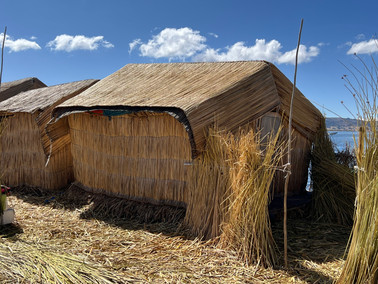Lake Titicaca
- bstclair579
- Jul 16, 2024
- 4 min read
Lake Titicaca is a unique place in the world. At 12,500 ft, it is the highest "navigable" lake in the world, which I guess means that large boats regularly cross the lake. It is also the largest lake in South America. It is large, and it is high. But it is also very interesting culturally.
We arrived in the city of Puno in the afternoon and went straight to the waterfront to find out about tours to the islands in Lake Titicaca. We booked an overnight tour to three islands for the next two days, and found a hostel near the docks for the night, and a secure place to park Hank.
The first island on the tour was to one of the floating islands of the Uros peoples. The islands are constructed from a type of sedge that grows in the shallows of the lake. The story is that the people immigrated from the Amazon region, but were continually oppressed by the people already living there, so for defensive reasons, they moved onto the man-made islands on the lake. Each island contains several thatched houses, usually belonging to a single extended family. The children take a boat every day to a nearby island for school, with older kids going to Puno. They supplement their incomes with tourism, including some beautifully embroidered textiles. They seemed like such a friendly and gentle people.
Next, we headed to Amatani Island, where we spent the night. Amantani Island has a population of about 4,000 people in 10 communities scattered around the island. They are determined to keep their traditional ways, and to manage the tourism on the island on their own. There are no cars or hotels. Overnight stays are with individual families and are generally rotated among families so everyone shares in the income from tourism. We had booked online beforehand, and stayed with a wonderfully friendly family, José Luis, his lovely wife, and nice son (Tikawasi homestay). Their place was very comfortable, and they cooked some wonderful meals for us. We also went with José Luis to the nearby village to a dance that was held for tourists and locals (where everyone dresses in traditional clothing, including us). Staying with such friendly, kind people was certainly a highlight of Lake Titicaca and Peru.
In the afternoon before dinner, I walked with our tour group to the top of one of two mountains on the island called Pachatata and Pachamama ("father earth" and "mother earth"). The two mountains have ancient ruins at the summits that pre-date the Incas. The ruins are closed during most of the year except one day when the islanders gather for a special ceremony. It was a steep climb to the top (and at over 13,000 ft), but well worth the effort for the view and spectacular sunset. Once at the top, I walked counter-clockwise three times around the ruins and left some coca leaves as a tribute. I also had a nice visit with one of our guides.
The third island was Taquile Island with another proud and special people. Taquile is known for their handwoven textiles (recognized by UNESCO as "Masterpieces of the Oral and Intangible Heritage of Humanity"). Our tour walked up the hill to the main town, where we found some excellent coffee, then were treated to a dance exhibition and a demonstration of weaving and knitting ,and learned about the local culture. Young men are those that do the knitting, while the women are the weavers. We bought a handwoven belt that is unique to their culture.
It was late in the afternoon when we returned to Puno. We decided to head down the highway a little bit towards Cusco. We stayed at a campground that was an old hacienda, now a horse farm owned by a couple from Switzerland. They weren't there, but the caretaker showed us where to park. It was a beautiful place with no other people around. At sunset and sunrise, the caretaker took the horses in to their stalls, and at sunrise, let them out to pasture. Beautiful creatures.
We had an interesting experience the next day on our way to Cusco. Coming into the larger city of Juliaca, we ran into some roadblocks. Turns out there were protests in the city and nearly all the streets were shut down with roadblocks of burning tires, ropes strung across the roads, and rocks and tires in the roads. From looking online we found out that a community activist was assassinated two days before and the city was fed-up with crime as well as police (18 people were killed by police in January 2023, known as the Juliaca massacre), so citizens shut down the city. Trying to drive through the city, we would drive down one street only to find it blocked. We kept trying different routes until finally we took some smaller unpaved city streets until we were on the other side of the city, but not near the main highway. Nevertheless, we took that highway for an hour until we could cut over to the main highway to Cusco.































































































































Great photos. Lucky you guys to have seen the floting villages. That's awesome.